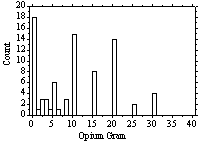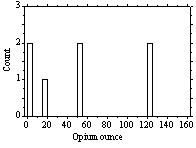|
|
Some articles have not been moved to our new site yet.
As a result you have been redirected to our old site.
If you wish to return to our new site - click here.
Opium in the UK
1. Introduction
1.1 Opium
is the raw exudate of the opium poppy (Papaver
somniferum) which is scraped from the scored seed
head of the poppy, which contains a number of alkaloids
including morphine and codeine.
1.2 Opium
is most commonly used as a raw material for the extraction
of morphine base, which in turn is treated chemically
to produce diacetylmorphine (heroin). Opium may be
smoked or eaten, but is rarely found within the UK.
2. Prevalence
2.1 Table
1 shows the number of opium seizures by police and
customs since 1990. There is no significant organised
market in raw Opium in the UK. Since 1990, there has
been an average of 40 opium seizures per year, mostly
from HM Customs, with an average quantity seized of
416 grams per seizure (399 seizures involving 166
kilos over 10 years). In recent years the number of
seizures has been falling, although the quantity seized
has been increasing.
|
Table
1 - UK Opium Seizures over 10 years 1990-99
|
|
Year
|
99
|
98
|
97
|
96
|
95
|
94
|
93
|
92
|
91
|
90
|
Total
|
|
No. of Seizures
|
22
|
35
|
30
|
23
|
36
|
35
|
65
|
57
|
49
|
47
|
399
|
|
Quantity
(kg)
|
37.7
|
54.6
|
17.8
|
11.4
|
5.5
|
11.2
|
8.2
|
3.8
|
8.0
|
7.6
|
165.8
|
2.2 Use
of opium is becoming more common (18% of users in
1998-2000 IDMU surveys), although for the vast majority
this involves a single use or on a small number of
occasions. In our 1984 survey, 6.7% of a sample of
608 recreational drug users had used the drug on at
least one occasion.
3. Consumption
3.1 Table
2 shows the distribution of experimental, occasional,
regular and daily users, and ages of initiation. The
daily users would be consuming between 0.5 and 3 grams
per day, depending on the quantity purchased at any
one time.
|
Table
2 - Frequency, Spending and Initiation to Opium
|
|
Frequency
of use
|
n
|
%
|
Avg
Monthly Spending
|
Age
first use
|
n
|
%
|
|
Experimental
|
711
|
12.52%
|
£10.76
|
<16
|
90
|
7%
|
|
Occasional
|
140
|
2.47%
|
£22.77
|
16-19
|
427
|
35%
|
|
Regular
|
16
|
0.28%
|
£30.00
|
20-24
|
454
|
38%
|
|
Daily
|
4
|
0.07%
|
£193.33
|
25-29
|
168
|
14%
|
|
Total
sample
|
5677
|
100.0%
|
-
|
30-39
|
60
|
5%
|
|
Total
ever
|
1059
|
18.65%
|
-
|
40+
|
8
|
1%
|
3.2 It
may be possible, in theory, to extract the morphine
base from the opium, and hence produce a quantity
of heroin as a result. It would be unreasonable to
speculate on a precise potential value of heroin which
could be produced from the opium seized in the absence
of forensic evidence as to the proportion by weight
of the substance attributable to morphine, from which
a potential yield and value of heroin could be calculated.
In the last century the range of morphine content
in opium was 1% to 20%, although 5% to 12% would be
typical values.
3.3 There
are very few other reports of opium use in the UK
or in modern societies. However, medicinal products
containing opium were widely available in the UK from
the 19th Century and in the UK until the 1960s under
trade names such as "Dovers Powders". Dovers
Powders were stated to have an active dose of between
1/4 and 1/2 gram of raw opium. The Earl of Mar, who
died in 1828, was reported to take 49 grains (3.2
grams) of raw opium per day, users of laudanum were
reported to take up to 40 ounces of mixture (2.6g
opium) per day. These would represent daily morphine
dosages of 104mg (2.6g @ 4%) to 416mg (3.2g @ 13%).
4 Opium
Prices
4.1 IDMU
has been monitoring Opium use and prices since 1998
(until then Opium was a "write-in" option).
Price reports range from £2 to £100 per gram (mean
price £19.26), and only seven ounce price reports
from £15 to £120, a mean price of £71.12 per ounce
(excluding two "free" reports).
|
Table
3 - UK & Regional Opium Prices 1998-2000
|
|
Unit
|
UK
|
Midlands
|
| |
n
|
mean
|
n
|
mean
|
|
Gram
|
97
|
£19.26
|
12
|
£14.90
|
|
Ounce
|
5
|
£71.12
|
1
|
£15.00
|
4.2 The
distribution of 1998-2000 Opium prices (excluding
single isolated reports of £45 and £100 per gram)
is shown in fig 1 below.
Fig
1 - Distribution of UK Opium Prices 1998-2000
 
4.3 Much
will depend on the source, e.g. a family or community
member from a producer country could expect to pay
very much less than a UK-based stranger with no connections.
For instance, in Afghanistan a kilo of opium costs
around £500, equivalent to £14 per ounce, and may
be expected to contain up to 10% morphine by weight.
4.4 It
would appear that there are two distinct types of
user, the recreational (white) user who would purchase
small quantities at high prices, and the regular (ethnic)
user who would be able to obtain larger quantities
at much reduced prices from within the ethnic community.
4.5 There
are a limited number of "official" reports
of opium prices, including £10 per gram (London Only
Sept 1996, £10,000 per kilo (no local gram prices)
in December 1997, and £250-£300 per ounce (Manchester
1996).
4.6 The
US State Department estimated that 570 metric tons
of opium produced in South East Asia could yield 57
tons of heroin. On this basis, 1 kilogram of opium
would be expected to produce up to 100 grams of heroin.
The former Soviet republic of Khirghizistan estimated
in 1993 that production of 100 tons of opium, containing
approximately 17% morphine, could yield $1 billion
in gross revenue. On this basis, 1 kilogram would
be worth $10,000 (approx £6500).
|
All contents of this web
site & any links to other sites etc, is for educational
& research purposes. IDMU at no time seeks to encourage
illegal activities. All sections of this site and its contents
are protected under copyright laws. © IDMU
Ltd 1994 - 2008
|
|
|
|